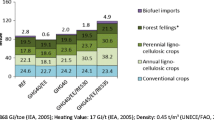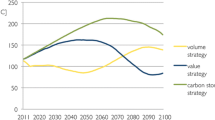Abstract
Preventing dangerous climate change requires actions on several sectors. Mitigation strategies have focused primarily on energy, because fossil fuels are the main source of global anthropogenic greenhouse gas emissions. Another important sector recently gaining more attention is the forest sector. Deforestation is responsible for approximately one fifth of the global emissions, while growing forests sequester and store significant amounts of carbon. Because energy and forest sectors and climate change are highly interlinked, their interactions need to be analysed in an integrated framework in order to better understand the consequences of different actions and policies, and find the most effective means to reduce emissions. This paper presents a model, which integrates energy use, forests and greenhouse gas emissions and describes the most important linkages between them. The model is applied for the case of Finland, where integrated analyses are of particular importance due to the abundant forest resources, major forest carbon sink and strong linkage with the energy sector. However, the results and their implications are discussed in a broader perspective. The results demonstrate how full integration of all net emissions into climate policy could increase the economic efficiency of climate change mitigation. Our numerical scenarios showed that enhancing forest carbon sinks would be a more cost-efficient mitigation strategy than using forests for bioenergy production, which would imply a lower sink. However, as forest carbon stock projections involve large uncertainties, their full integration to emission targets can introduce new and notable risks for mitigation strategies.








Similar content being viewed by others
Notes
A small negative price is set because otherwise there would be no incentive to care about the forest carbon sink and do rational harvesting decisions, like thin during the stage of fast growth and final fell close or after the saturation of growth. The price is kept small so that it does not affect other decisions made by the model, such as the total harvested volume.
References
Äijälä O, Koistinen A, Sved J, Vanhatalo K, Väisänen P (eds.) (2014) Metsänhoidon suositukset. Metsätalouden kehittämiskeskus Tapion julkaisuja
Bioeconomy Strategy (2014) Sustainable growth from bioeconomy—the Finnish Bioeconomy Strategy
Böttcher H, Verkerk PJ, Gusti M, HavlÍk P, Grassi G (2012) Projection of the future EU forest CO2 sink as affected by recent bioenergy policies using two advanced forest management models. GCB Bioenergy 4(6):773–783
Brenkert A, Smith S, Kim S, Pitcher H (2003) Model documentation for the MiniCAM. Pacific Northwest National Laboratory Richland, WA
Crowther TW, Glick HB, Covey KR, Bettigole C, Maynard DS, Thomas SM, Smith JR, Hintler G, Duguid MC, Amatulli G, Tuanmu MN, Jetz W, Salas C, Stam C, Piotto D, Tavani R, Green S, Bruce G, Williams SJ, Wiser SK, Huber MO, Hengeveld GM, Nabuurs GJ, Tikhonova E, Borchardt P, Li CF, Powrie LW, Fischer M, Hemp A, Homeier J, Cho P, Vibrans AC, Umunay PM, Piao SL, Rowe CW, Ashton MS, Crane PR, Bradford MA (2015) Mapping tree density at a global scale. Nature 525:201–205
Dieckhoff P, El-Cichakli B, Patermann C (2015) Bioeconomy policy (part II)—synopsis of national strategies around the world. A report from the German Bioeconomy Council
Ekholm T (2016) Optimal forest rotation age under efficient climate change mitigation. Forest Policy and Economics 62:62–68. doi:10.1016/j.forpol.2015.10.007
Ellison D, Lundblad M, Petersson H (2014) Reforming the eu approach to LULUCF and the climate policy framework. Environmental Science andamp; Policy 40:1–15
Energy and Climate Strategy (2013) National Energy and Climate Strategy—Government Report to Parliament on 20 March 2013
European Commission (2011) A roadmap for moving to a competitive low carbon economy in 2050. COM(2011) 112 final
European Commission (2012) Innovating sustainable growth: a bioeconomy for Europe. COM(2012) 60 final
European Commission (2016) Proposal for a Regulation of the European Parliament and of the Council on the inclusion of greenhouse gas emissions and removals from land use, land use change and forestry into the 2030 climate and energy framework and amending Regulation No 525/2013 of the European Parliament and the Council on a mechanism for monitoring and reporting greenhouse gas emissions and other information relevant to climate change. COM(2016) 479 final
Eurostat (2016) Forestry and climate change. Available at http://ec.europa.eu/eurostat/statistics-explained/index.php/Forestry_and_climat_change
Finnish Forest Research Institute (2013) Finnish statistical yearbook of forestry 2013. Vammalan Kirjapaino Oy, Sastamala, Finland. In Finnish
Gustavsson L, Madlener R, Hoen HF, Jungmeier G, Karjalainen T, Klöhn S, Mahapatra K, Pohjola J, Solberg B, Spelter H (2006) The role of wood material for greenhouse gas mitigation. Mitig Adapt Strateg Glob Chang 11 (5):1097–1127. doi:10.1007/s11027-006-9035-8
Hansen MC, Potapov PV, Moore R, Hancher M, Turubanova SA, Tyukavina A, Thau D, Stehman SV, Goetz SJ, Loveland TR, Kommareddy A, Egorov A, Chini L, Justice CO, Townshend JRG (2013) High-resolution global maps of 21st-century forest cover change. Science 342 (6160):850–853. doi:10.1126/science.1244693
Haskett J, Schlamadinger B, Brown S (2010) Land-based carbon storage and the European Union emissions trading scheme: the science underlying the policy. Mitig Adapt Strateg Glob Chang 15(2):127–136
IEA (2015) Energy and climate change—world energy outlook special report. International Energy Agency IEA
Joint Global Change Research Institute (2016) GCAM v4.3 documentation: Global Change Assessment Model (GCAM). Retrieved December 8, 2016 from GCAM Wiki: http://jgcri.github.io/gcam-doc/index.html
Kangas AS (1997) On the prediction bias and variance in long-term growth projections. For Ecol Manag 96(3):207–216
Koljonen T, Lehtilä A (2015) Modelling pathways to a low carbon economy for Finland. In: Giannakidis G, Labriet M, Ó Gallachóir B, Tosato G (eds) Informing energy and climate policies using energy systems models: insights from scenario analysis increasing the evidence base. Springer International Publishing, pp 163–181
Lehtonen A, Mäkipää R, Heikkinen J, Sievänen R, Liski J (2004) Biomass expansion factors (BEFs) for scots pine, Norway spruce and birch according to stand age for boreal forests. For Ecol Manag 188(1):211–224
Loulou R, Labriet M (2008) ETSAP-TIAM: the TIMES integrated assessment model Part I: model structure. Comput Manag Scix 5(1-2):7–40
Marland G, Fruit K, Sedjo R (2001) Accounting for sequestered carbon: the question of permanence. Environ Sci Policy 4(6):259–268. doi:10.1016/S1462-9011(01)00038-7
Matala J, Ojansuu R, Peltola H, Sievänen R, Kellomäki S (2005) Introducing effects of temperature and CO2 elevation on tree growth into a statistical growth and yield model. Ecol Modell 181 (2):173–190
Ministry of Agriculture and Forestry Finland (1996). Forest Act. 1093/1996
Monni S, Peltoniemi M, Palosuo T, Lehtonen A, Mäkipää R, Savolainen I (2007a) Uncertainty of forest carbon stock changes—implications to the total uncertainty of GHG inventory of Finland. Climatic Change 81(3):391–413. doi:10.1007/s10584-006-9140-4
Monni S, Peltoniemi M, Palosuo T, Lehtonen A, Mäkipää R, Savolainen I (2007b) Uncertainty of forest carbon stock changes—implications to the total uncertainty of GHG inventory of Finland. Clim Chang 81(3-4):391–413
Nabuurs GJ, Lindner M, Verkerk PJ, Gunia K, Deda P, Michalak R, Grassi G (2013) First signs of carbon sink saturation in european forest biomass. Nat Clim Chang 3(9):792–796
Natural Resources Institute Finland (2012) Metla Metinfo VMI tilastot [Metsävarat metsäkeskuksittain – inventointien VMI9–VMI11 tuloksia]. Retrieved, 2016 from http://mela2.metla.fi/mela/tupa/index.php
Natural Resources Institute Finland (2015a) MELA Tulospalvelu [TuPa hakupalvelu - VMI11 (mittausvuodet 2009-2013)]. Retrieved February 11, 2016 from http://mela2.metla.fi/mela/tupa/index.php
Natural Resources Institute Finland (2015b) Statisticts database [Total roundwood removals]. Retrieved February 12, 2016 from http://statdb.luke.fi/PXWeb/pxweb/en/LUKE/LUKE__04%20Metsa__02%20Rakenne%20ja%20tuotanto__10%20Hakkuukertyma%20ja%20puuston%20poistuma/01_Hakkuukertyma.px/?rxid=8f94b4b4-2407-4210-8de5-68e808f11d94
Pan Y, Birdsey RA, Fang J, Houghton R, Kauppi PE, Kurz WA, Phillips OL, Shvidenko A, Lewis SL, Canadell JG et al (2011) A large and persistent carbon sink in the world’s forests. Science 333(6045):988–993
Parliamentary Committee on Energy and Climate Issues (2014) Energy and climate roadmap 2050—Report of the Parliamentary Committee on Energy and Climate Issues on 16 October 2014. Publications of the Ministry of Employment and the Economy - Energy and the Climate 50/2014
Persson UM (2012) Conserve or convert? Pan-tropical modeling of REDD—bioenergy competition. Biol Conserv 146(1):81–88. doi:10.1016/j.biocon.2011.10.038
Pingoud K, Perälä A et al (2000) Studies on greenhouse impacts of wood construction: 1. Scenario analysis of potential wood utilisation in Finnish new construction in 1990 and 1994 2. Inventory of carbon stock of wood products in the Finnish building stock in 1980, 1990 and 1995. VTT Julkaisuja, (840)
Pingoud K, Ekholm T, Savolainen I (2012) Global warming potential factors and warming payback time as climate indicators of forest biomass use. Mitig Adapt Strateg Glob Chang 17(4):369–386. doi:10.1007/s11027-011-9331-9
Pingoud K, Ekholm T, Soimakallio S, Helin T (2016) Carbon balance indicator for forest bioenergy scenarios. GCB Bioenergy 8(1):171–182
Pires JCM, Martins FG, Alvim-Ferraz MCM, Simões M (2011) Recent developments on carbon capture and storage: an overview. Chem Eng Res Des 89 (9):1446–1460
Pouzols FM, Toivonen T, Minin ED, Kukkala AS, Kullberg P, Kuusterä J, Lehtomäki J, Tenkanen H, Verburg PH, Moilanen A (2014) Global protected area expansion is compromised by projected land-use and parochialism. Nature 516:383–386. doi:10.1038/nature14032
Riahi K, Grübler A, Nakicenovic N (2007) Scenarios of long-term socio-economic and environmental development under climate stabilization. Technol Forecast Soc Chang 74(7):887–935. doi:10.1016/j.techfore.2006.05.026
Sathre R, Gustavsson L (2006) Energy and carbon balances of wood cascade chains. Resour, Conserv Recycl 47(4):332–355. doi:10.1016/j.resconrec.2005.12.008
Scarlat N, Dallemand JF, Monforti-Ferrario F, Nita V (2015) The role of biomass and bioenergy in a future bioeconomy: policies and facts. Environ Dev 15:3–34
Schlamadinger B, Spitzer J, Kohlmaier G, Lüdeke M (1995) Carbon balance of bioenergy from logging residues. Biomass Bioenergy 8(4):221–234. doi:10.1016/0961-9534(95)00020-8
Siitonen M, Anola-Pukkila A, Härkönen H K A, Redsven V, Salminen O, Suokas Ae (2001) MELA handbook—2000 edition. The Finnish Forest Research Institute
Sokolov AP, Schlosser CA, Dutkiewicz S, Paltsev S, Kicklighter DW, Jacoby HD, Prinn RG, Forest CE, Reilly JM, Wang C et al (2005) MIT Integrated Global System Model (IGSM) version 2: model description and baseline evaluation. Technical. report. MIT Joint Program on the Science and Policy of Global Change
Statistics Finland (2015) Statisticts Finland’s PX-Web databases [Greenhouse gas emissions in Finland]. Retrieved February 12, 2016 from http://pxnet2.stat.fi/PXWeb/pxweb/en/StatFin/StatFin__ymp__khki/010_khki_tau_101.px/?rxid=5b3acd25-a776-47b7-91eb-4f2dd268649e
Stehfest E, Van Vuuren D, Kram T, Bouwman L, Alkemade R, Bakkenes M, Biemans H, Bouwman A, Den Elzen M, Janse J, Lucas P, Van Minnen J, Müller M, Prins A (2014) Integrated Assessment of Global Environmental Change with IMAGE 3.0.—model description and policy applications. The Hague: PBL Netherlands Environmental Assessment Agency
UNFCCC (2015) Synthesis report on the aggregate effect of the intended nationally determined contributions
UNFCCC (2016a) Adoption of the Paris Agreement—Decision 1/CP.21. FCCC/CP/2015/10/Add.1
UNFCCC (2016b) Synthesis report on the aggregate effect of the Intended Nationally Determined Contributions, FCCC/CP/2015/7
Vass MM, Elofsson K (2016) Is forest carbon sequestration at the expense of bioenergy and forest products cost-efficient in eu climate policy to 2050? J For Econ 24:82–105
Vis M, Mantau U, Allen B (2016) Study on the optimised cascading use of wood. No 394/PP/ENT/RCH/14/7689. Final report, Brussels, p 337
Wise M, Calvin K, Thomson A, Clarke L, Bond-Lamberty B, Sands R, Smith SJ, Janetos A, Edmonds J (2009) Implications of limiting CO2 concentrations for land use and energy. Science 324(5931):1183–1186
Zomer RJ, Trabucco A, Bossio DA, Verchot LV (2008) Climate change mitigation: a spatial analysis of global land suitability for clean development mechanism afforestation and reforestation. Agric Ecosyst Environ 126(1–2):67 – 80. doi:10.1016/j.agee.2008.01.014
Acknowledgements
The research has been done in the project ECOSUS, funded by the Academy of Finland (decision no.: 257174).
Author information
Authors and Affiliations
Corresponding author
Rights and permissions
About this article
Cite this article
Siljander, R., Ekholm, T. Integrated scenario modelling of energy, greenhouse gas emissions and forestry. Mitig Adapt Strateg Glob Change 23, 783–802 (2018). https://doi.org/10.1007/s11027-017-9759-7
Received:
Accepted:
Published:
Issue Date:
DOI: https://doi.org/10.1007/s11027-017-9759-7




